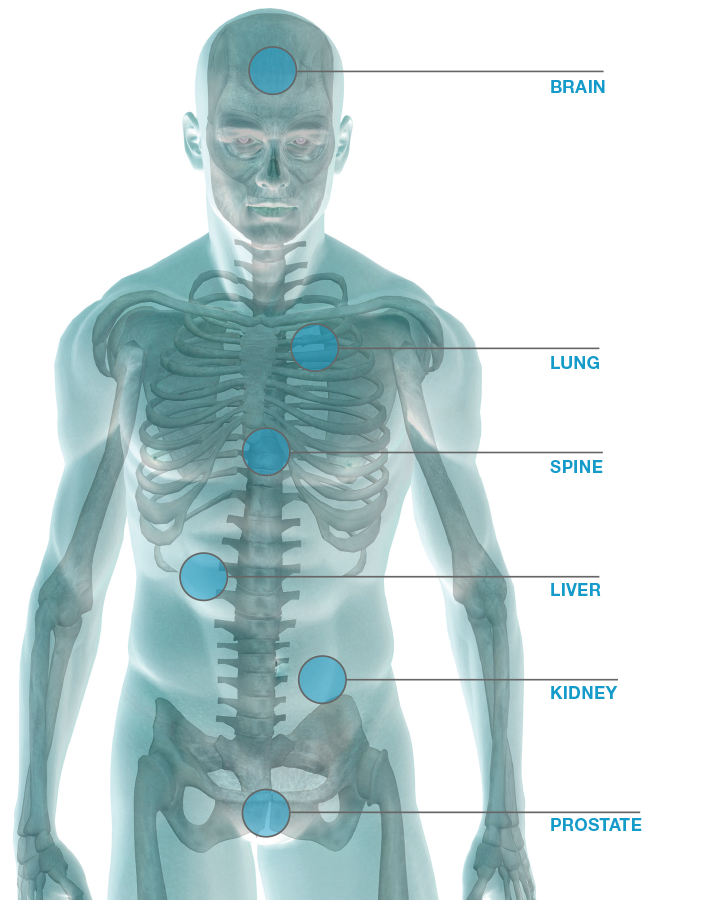
|
Cyber Knife Sterotactic Advanced Radiosurgery and Your Frequently Asked Questions Here you can find out more about how treatment works and what the treatment with proton therapy is like in terms of both having treatment and what happens after treatment is complete. You can also watch videos presented by the doctors and the healthcare team who will treat you as well as hear from former patients about both the treatment with proton therapy as well as the additional support in terms of emotional care and day to day practical care which is so important when experiencing a serious illness. To help you navigate around this page on my site below is a simple listing which will take you to the right section on this webpage. Please contact me if you have any further questions on the content of this page.
|
HOW DOES CYBERKNIFE STEROTACTIC RADIOSURGERY WORK AND HOW IS IT USED
|
Innovative
technique - outpatient cancer therapy Cyberknife offers an innovative and evidence based treatment alternative for a variety of tumors throughout the body. Patient movement is automatically detected and corrected up to sub-millimetre accuracy. Using this ultra fast correction technology it is possible to provide high precision radiosurgical treatment of tumors without invasive fixing of the head or other regions of the body. Advantages
of treatment In such a way also lesions in very sensitive body parts can be eliminated while maximally sparing the surrounding healthy tissue. Pain free surgery The newly developed Cyberknife technology offers pain-free, outpatient "surgery". There are no complications from fixations, no anaesthesia, no surgical incisions. No inpatient hospital stay is required, also no subsequent cure or rehabilitation time. Precision robotics The first innovation consists of a particularly lightweight and compact radiation device mounted on a robotic arm. The precision robot - which is also used in the automobile industry - can move freely in 6 plains. Thus all body parts can be accessed without problems for an optimal treatment. The system is clearly more flexible in handling and hence more effective than conventional systems. Image guidance system The second innovation consists of a computer assisted image guidance targeting system. With this technology the Cyberknife can target the tumor throughout the treatment and smaller patient movements can be compensated for. Thus it is no longer necessary to fix the head of the patient in a frame, to immobilize the body or to administer anaesthesia, as is required for conventional systems. Respiratory Compensation The third technical innovation relates to the capability of the treatment beam to follow moving targets. This is particularly important for tumors in the lung, liver and renal gland as they move considerably with breathing. In conventional radiation therapy patients are therefore put into fixating devices and a larger margin around the lesion is applied to be certain to hit the target during treatment. Sometimes the patient is even put into breath arrest during beam on times. Cyberknife does not need these rather cumbersome techniques: External breathing is monitored with a infrared camera and correlated with the internal tumor motion. The robot is following then the tumor during treatment and one can say Cyberknife is breathing with the patient. The technology is adapting to the patient and not the other way as in conventional systems. Duration of treatment The Cyberknife treatment as a rule is a single session treatment. It lasts between 45 minutes to 90 minutes depending on the indication. Immediately after the treatment the patient can resume his normal daily activities. A further visit for a follow-up examination is recommended after 4 to 6 months only. Indications
of treatment Using the latest in medical high technology allows it to treat even very irregularly shaped tumors in the area of critical brain regions such as the visual or auditive nerve, without damage to these sensitive brain areas. Brain Acoustic
neuroma
Spinal
metastases
Lung
cancer (stage I/II)
Primary
liver carcinoma
Renal
cell carcinoma
Prostate
cancer
|
| Home | What I Do | How I Work With You | Media | Contact Me |
(c) Steven Warren 1996-2016. All rights reserved. Privacy
